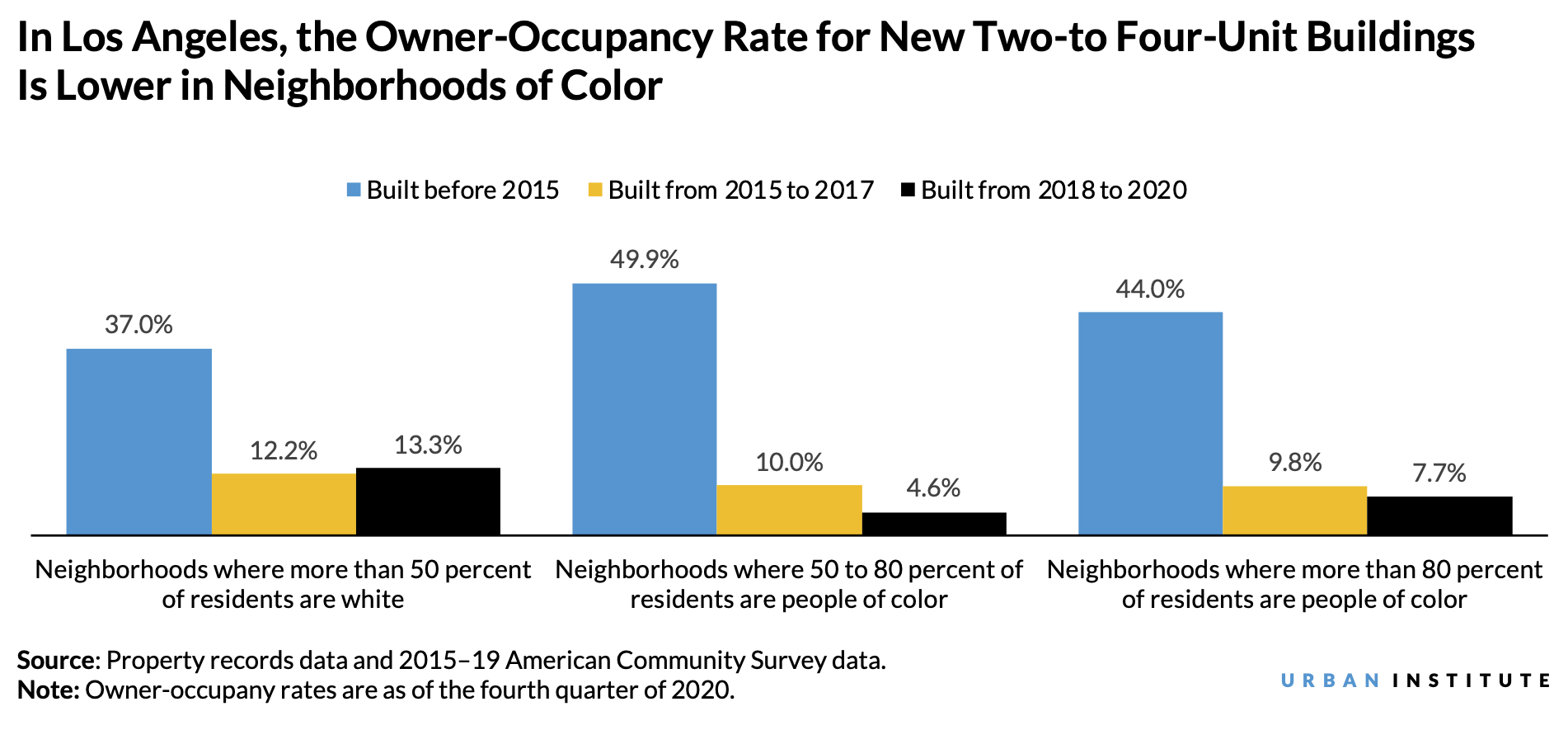
Los Angeles has long grappled with a severe housing supply shortage and a notorious affordability crisis. To address these issues, policymakers are seeking creative solutions to increase the housing supply. One option is to expand the supply of low-rise infill housing, which includes accessory dwelling units (ADUs) and two-to-four-unit homes.
Until recently, two-to-four-unit housing could be built only in multifamily zones. But in September 2021, California enacted Senate Bill 9 (SB 9), which allows by-right duplexes and lot splits on most single-family lots throughout the state. This presents a historic new opportunity to increase the amount of low-rise infill housing in single-family zones.
As part of a research project, Urban Institute researchers discussed recent findings about the current supply of low-density infill housing in LA with three experts from academia and industry. The conversation shed light on an important question: How can we ensure this new housing production results in more equitable outcomes for neighborhoods and people?
Where low-rise infill homes are currently located
To answer the question, we must first understand where low-rise infill housing is located.
ADUs are a relatively new but growing component of the Los Angeles housing stock. Slightly larger units, however, have been part of the city’s landscape for decades. Because of Los Angeles’s exclusionary zoning policies and history of racial segregation, nearly 80 percent of all two-to-four-unit housing is concentrated in low- and moderate-income (LMI) neighborhoods with primarily residents of color. Those LMI neighborhoods of color have fewer resources (PDF) than other neighborhoods, such as proximity to employment and educational opportunities.
Most of the existing stock of two-to-four-unit homes was built before 2015. Evidence shows that the owner-occupancy rate for two-to-four-unit structures built recently has been falling in neighborhoods of color.

What’s more, those new homes are more heavily concentrated in LMI neighborhoods, where assessed property values are increasing substantially based on our analysis of First American’s property records data. This suggests that new two-to-four-unit homes may be less affordable to potential homebuyers, though the increased value of existing properties would benefit current owners.
How SB 9 will influence equitable outcomes for people and neighborhoods
This landscape of two-to-four-unit housing partially motivated the adoption of SB 9, which permits more flexible housing types in single-family zones. It marks a major step toward opening up formerly exclusive neighborhoods but still may not directly benefit LMI families and neighborhoods—at least, not without additional policy intervention, according to experts the Urban Institute consulted.
Here are a few facts policymakers should consider if their goal is to ensure SB 9 promotes equitable outcomes:
- SB 9 alone isn’t enough to guarantee building in LMI neighborhoods.
Mott Smith, founding board member of the Council of Infill Builders and adjunct professor at University of Southern California, emphasized the importance of understanding the difference between equitable zoning and equitable outcomes. “We need to start thinking about zoning that will generate equitable outcomes—such as moves to make it easier for LMI people to become first-time homeowners and small-scale landlords, and that might look very different from the zoning that by itself might appear equitable,” said Smith. SB 9 provides broad upzoning, so LMI communities are not the only places where low-density residences can be built. Additional barriers will need to be removed so small-scale development is accessible to all homeowners, not only wealthy ones. - Increasing production won’t automatically help close the homeownership gap.
William Fulton, director of the Kinder Institute for Urban Research at Rice University, highlighted the implications associated with housing supply increases in single-family zones. On one hand, he suggested, we will likely see more developers build low-density infill housing in West Los Angeles or other relatively affluent single-family neighborhoods, which would increase supply. On the other hand, those neighborhoods tend to be more expensive and less affordable.
Because of historical structural barriers, coupled with the higher cost of land and construction in single-family zones, Fulton noted that the amount of net new units could be limited and unaffordable for LMI households of color, suggesting that increasing production won’t significantly help close the homeownership gap for Black and Latinx households absent other policy incentives.
But if government policies add affordability requirements to the new housing, developers will have fewer financial incentives to build, limiting the volume of construction of new units. - Absent additional protections, there’s a risk of displacement and gentrification.
Policymakers should also be aware of the declining owner-occupancy rate in neighborhoods of color. Although SB 9 has displacement protections, experts worried about the possibility of secondary displacement and gentrification in LMI neighborhoods of color to the extent that new construction does occur there. “We will have a number of families who have modest incomes get pushed out of the neighborhoods they love because they can’t afford…all those things middle- and higher middle-class households desire,” said Lori Gay, CEO of Neighborhood Housing Services of Los Angeles County. “With developers and investors building new properties in their neighborhoods, they won’t be able to stay.” - Communities need additional resources to support existing residents.
Smith also pointed out that making development work for the in-place community will require investing in resources. Long-term residents may need stronger financial and technical support to help them become first-time homeowners and, potentially, small-scale landlords. “We need to give people the power to shape their communities, to invest in their communities and infrastructure, and to build housing wealth in their communities,” said Smith.
A multifaceted approach will be key
In Los Angeles, there is a need to build more, wherever possible. Policymakers can use the considerations above to develop additional policies that complement SB 9. Innovative homeownership models, such as community land trusts; reduced regulatory barriers; and technical and financial assistance may be necessary to ensure policy changes benefit LMI households and neighborhoods.
Ultimately, more research is needed to study the impacts of the zoning changes and determine additional policies that could further equity and ensure homeowners and neighborhoods most in need don’t get left behind.
The Urban Institute has the evidence to show what it will take to create a society where everyone has a fair shot at achieving their vision of success.
Let’s build a future where everyone, everywhere has the opportunity and power to thrive
Urban is more determined than ever to partner with changemakers to unlock opportunities that give people across the country a fair shot at reaching their fullest potential. Invest in Urban to power this type of work.